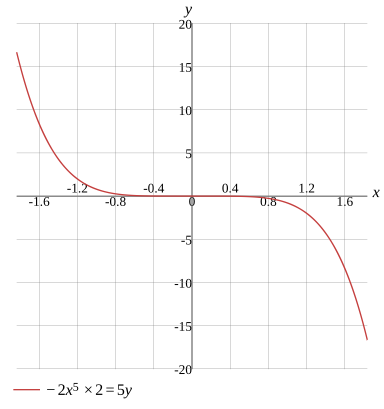Question
Function
Find the x-intercept/zero
Find the y-intercept
x=0
Evaluate
−2x5×2=5y
To find the x-intercept,set y=0
−2x5×2=5×0
Any expression multiplied by 0 equals 0
−2x5×2=0
Multiply the terms
−4x5=0
Change the signs on both sides of the equation
4x5=0
Rewrite the expression
x5=0
Solution
x=0
Show Solution

Solve the equation
Solve for x
Solve for y
x=−2540y
Evaluate
−2x5×2=5y
Multiply the terms
−4x5=5y
Change the signs on both sides of the equation
4x5=−5y
Divide both sides
44x5=4−5y
Divide the numbers
x5=4−5y
Use b−a=−ba=−ba to rewrite the fraction
x5=−45y
Take the 5-th root on both sides of the equation
5x5=5−45y
Calculate
x=5−45y
Solution
More Steps


Evaluate
5−45y
To take a root of a fraction,take the root of the numerator and denominator separately
545−5y
Multiply by the Conjugate
54×5445−5y×544
Calculate
225−5y×544
Calculate
More Steps


Evaluate
5−5y×544
The product of roots with the same index is equal to the root of the product
5−5y×44
Calculate the product
5−1280y
An odd root of a negative radicand is always a negative
−51280y
Simplify the radical expression
−2540y
22−2540y
Divide the terms
More Steps


Evaluate
22−2
Use the product rule aman=an−m to simplify the expression
22−1−1
Subtract the terms
21−1
Simplify
2−1
Use b−a=−ba=−ba to rewrite the fraction
−21
2−540y
Calculate
−2540y
x=−2540y
Show Solution

Testing for symmetry
Testing for symmetry about the origin
Testing for symmetry about the x-axis
Testing for symmetry about the y-axis
Symmetry with respect to the origin
Evaluate
−2x52=5y
Simplify the expression
−4x5=5y
To test if the graph of −4x5=5y is symmetry with respect to the origin,substitute -x for x and -y for y
−4(−x)5=5(−y)
Evaluate
More Steps


Evaluate
−4(−x)5
Rewrite the expression
−4(−x5)
Multiply the numbers
4x5
4x5=5(−y)
Evaluate
4x5=−5y
Solution
Symmetry with respect to the origin
Show Solution

Rewrite the equation
r=0r=24−20sin(θ)sec(θ)×∣sec(θ)∣r=−24−20sin(θ)sec(θ)×∣sec(θ)∣
Evaluate
−2x5×2=5y
Evaluate
−4x5=5y
Move the expression to the left side
−4x5−5y=0
To convert the equation to polar coordinates,substitute x for rcos(θ) and y for rsin(θ)
−4(cos(θ)×r)5−5sin(θ)×r=0
Factor the expression
−4cos5(θ)×r5−5sin(θ)×r=0
Factor the expression
r(−4cos5(θ)×r4−5sin(θ))=0
When the product of factors equals 0,at least one factor is 0
r=0−4cos5(θ)×r4−5sin(θ)=0
Solution
More Steps


Factor the expression
−4cos5(θ)×r4−5sin(θ)=0
Subtract the terms
−4cos5(θ)×r4−5sin(θ)−(−5sin(θ))=0−(−5sin(θ))
Evaluate
−4cos5(θ)×r4=5sin(θ)
Divide the terms
r4=−4cos5(θ)5sin(θ)
Simplify the expression
r4=−45sin(θ)sec5(θ)
Evaluate the power
r=±4−45sin(θ)sec5(θ)
Simplify the expression
More Steps


Evaluate
4−45sin(θ)sec5(θ)
To take a root of a fraction,take the root of the numerator and denominator separately
444−5sin(θ)sec5(θ)
Simplify the radical expression
444−5sin(θ)sec(θ)×∣sec(θ)∣
Simplify the radical expression
24−5sin(θ)sec(θ)×∣sec(θ)∣
Multiply by the Conjugate
2×24−5sin(θ)sec(θ)×∣sec(θ)∣×2
Calculate
24−5sin(θ)sec(θ)×∣sec(θ)∣×2
Calculate the product
24−20sin(θ)sec(θ)×∣sec(θ)∣
r=±24−20sin(θ)sec(θ)×∣sec(θ)∣
Separate into possible cases
r=24−20sin(θ)sec(θ)×∣sec(θ)∣r=−24−20sin(θ)sec(θ)×∣sec(θ)∣
r=0r=24−20sin(θ)sec(θ)×∣sec(θ)∣r=−24−20sin(θ)sec(θ)×∣sec(θ)∣
Show Solution

Find the first derivative
Find the derivative with respect to x
Find the derivative with respect to y
dxdy=−4x4
Calculate
−2x52=5y
Simplify the expression
−4x5=5y
Take the derivative of both sides
dxd(−4x5)=dxd(5y)
Calculate the derivative
More Steps


Evaluate
dxd(−4x5)
Use differentiation rule dxd(cf(x))=c×dxd(f(x))
−4×dxd(x5)
Use dxdxn=nxn−1 to find derivative
−4×5x4
Multiply the terms
−20x4
−20x4=dxd(5y)
Calculate the derivative
More Steps


Evaluate
dxd(5y)
Use differentiation rules
dyd(5y)×dxdy
Evaluate the derivative
More Steps


Evaluate
dyd(5y)
Use differentiation rule dxd(cf(x))=c×dxd(f(x))
5×dyd(y)
Use dxdxn=nxn−1 to find derivative
5×1
Any expression multiplied by 1 remains the same
5
5dxdy
−20x4=5dxdy
Swap the sides of the equation
5dxdy=−20x4
Divide both sides
55dxdy=5−20x4
Divide the numbers
dxdy=5−20x4
Solution
More Steps


Evaluate
5−20x4
Reduce the numbers
1−4x4
Calculate
−4x4
dxdy=−4x4
Show Solution

Find the second derivative
Find the second derivative with respect to x
Find the second derivative with respect to y
dx2d2y=−16x3
Calculate
−2x52=5y
Simplify the expression
−4x5=5y
Take the derivative of both sides
dxd(−4x5)=dxd(5y)
Calculate the derivative
More Steps


Evaluate
dxd(−4x5)
Use differentiation rule dxd(cf(x))=c×dxd(f(x))
−4×dxd(x5)
Use dxdxn=nxn−1 to find derivative
−4×5x4
Multiply the terms
−20x4
−20x4=dxd(5y)
Calculate the derivative
More Steps


Evaluate
dxd(5y)
Use differentiation rules
dyd(5y)×dxdy
Evaluate the derivative
More Steps


Evaluate
dyd(5y)
Use differentiation rule dxd(cf(x))=c×dxd(f(x))
5×dyd(y)
Use dxdxn=nxn−1 to find derivative
5×1
Any expression multiplied by 1 remains the same
5
5dxdy
−20x4=5dxdy
Swap the sides of the equation
5dxdy=−20x4
Divide both sides
55dxdy=5−20x4
Divide the numbers
dxdy=5−20x4
Divide the numbers
More Steps


Evaluate
5−20x4
Reduce the numbers
1−4x4
Calculate
−4x4
dxdy=−4x4
Take the derivative of both sides
dxd(dxdy)=dxd(−4x4)
Calculate the derivative
dx2d2y=dxd(−4x4)
Simplify
dx2d2y=−4×dxd(x4)
Rewrite the expression
dx2d2y=−4×4x3
Solution
dx2d2y=−16x3
Show Solution

Graph
